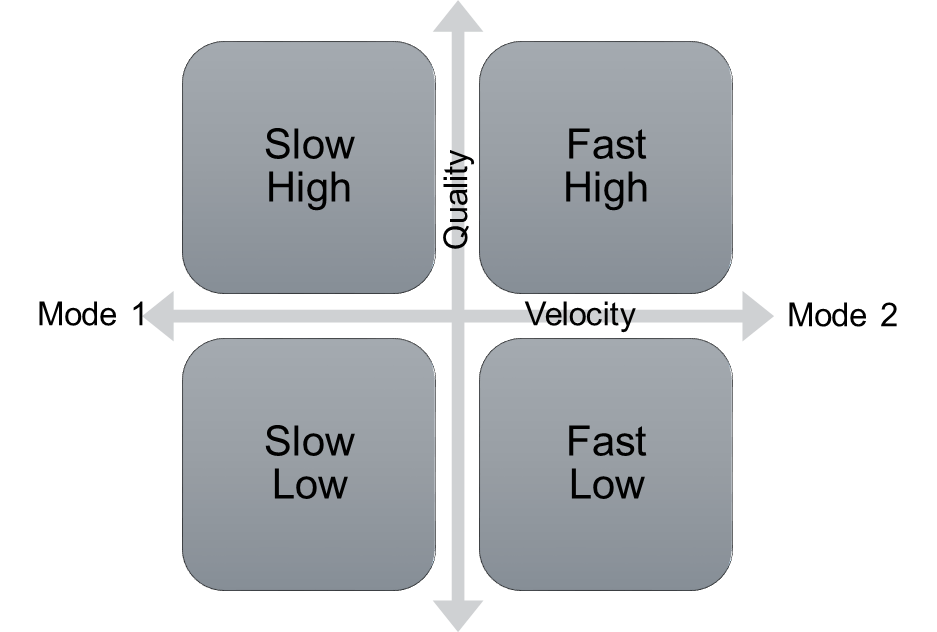The research firm Gartner recently coined the term bimodal IT as a way to describe the need for IT organizations to support the diverse demands of the digital transformation that affects almost every enterprise. Many organizations are working on digital transformation in an effort to better engage with their customers and business partners and ultimately achieve a competitive advantage.
But Gartner's vision of bimodal IT implies a tradeoff between velocity and quality that simply doesn't exist if you're doing DevOps. Your management may be reading this stuff. Don't let them be fooled. Here's how to arm yourself with the facts.
What is bimodal IT?
Gartner's bimodal IT model declares that there are two distinct ways for IT to operate in order to meet the demands of the digital economy. “Bimodal IT is the practice of managing two separate, coherent modes of IT delivery, one focused on stability and the other on agility. Mode 1 is traditional and sequential, emphasizing safety and accuracy. Mode 2 is exploratory and nonlinear, emphasizing agility and speed,” according to the Gartner Glossary. So far, so good.
The bimodal assertion: You can't increase velocity and quality
While the bimodal model may help to explain the conflict that often exists in IT organizations between agile and linear projects, there is a fly in the bimodal ointment.
The definition implies that Mode 1 (quality and safety) and Mode 2 (speed and agility) are somehow mutually exclusive. At its core, the implied tradeoff here is velocity versus quality. Gartner's assumption is that the faster delivery associated with speed and agility comes at the cost of quality. That, however, is most definitely not what many enterprises have experienced when adopting the principles of DevOps.
Consider, Jez Humble's recent post where he wrote, “Gartner’s model rests on a false assumption that is still pervasive in our industry: that we must trade off responsiveness against reliability. The conventional wisdom is that if we make changes to our products and services faster and more frequently, we will reduce their stability, increase our costs, and compromise on quality.”
The State of DevOps Report provides evidence to the contrary
If you need evidence to support this argument, show your management the 2015 State of DevOps Report. This survey shows that, for organizations using a DevOps approach, quality improves with increased velocity.
“The fact that stability increased in our high-performing group suggests that quality is shifting to the left — that is, it’s being built into the software earlier in the development process,” the report concludes.
In Gartner’s Mode1 vs Mode 2 definition, the description of the quality-versus-speed tradeoff is simply wrong. Mode 2 can be very high quality, while many Mode 1 projects deliver questionable quality. DevOps, done right, is based on the principles of lean and continuous improvement described in Kaizen: Quality improves as waste is removed, leading to velocity.
The right way to think about bimodal IT
A better way to think about this is:
Mode 1 = slow
Mode 2 = fast.
Quality can be high with both approaches. The driver for the quadrant in which a team should operate depends on the business need.

What are your experiences? If you’re doing DevOps, take a few minutes to share them right now by taking part in this year's State of DevOps Survey. With input from developers, testers, administrators, IT leaders—people like you—this report will build on the 2015 survey to help practitioners learn from each other as to what works, what doesn’t, and how to succeed with DevOps.
Keep learning
Take a deep dive into the state of quality with TechBeacon's Guide. Plus: Download the free World Quality Report 2022-23.
Put performance engineering into practice with these top 10 performance engineering techniques that work.
Find to tools you need with TechBeacon's Buyer's Guide for Selecting Software Test Automation Tools.
Discover best practices for reducing software defects with TechBeacon's Guide.
- Take your testing career to the next level. TechBeacon's Careers Topic Center provides expert advice to prepare you for your next move.


